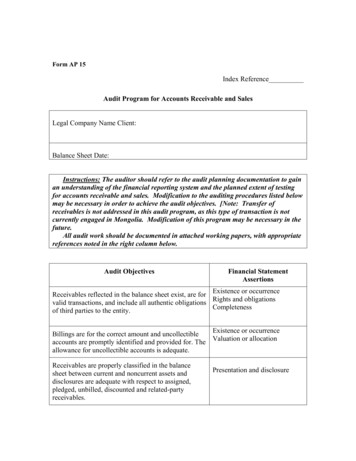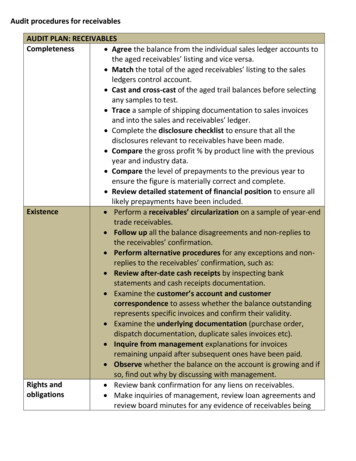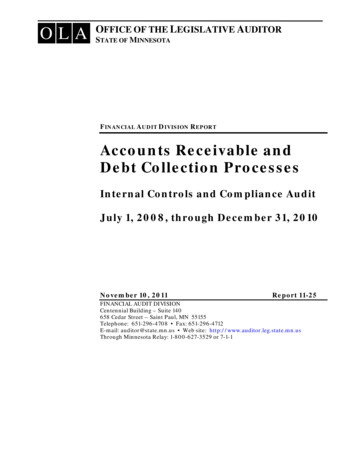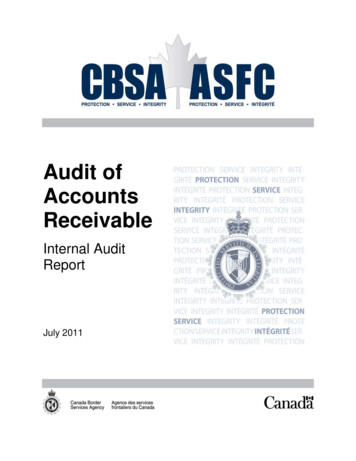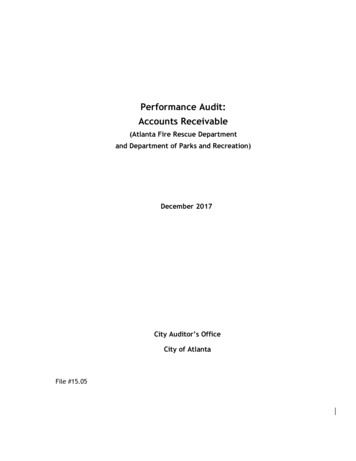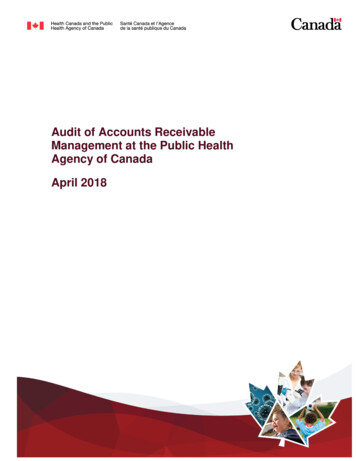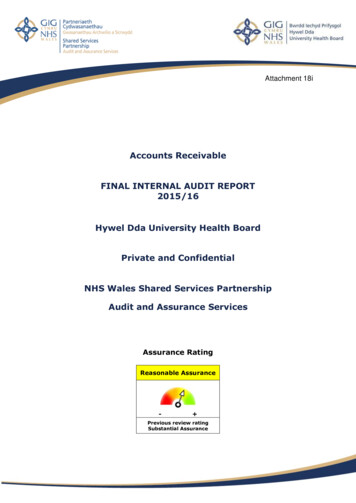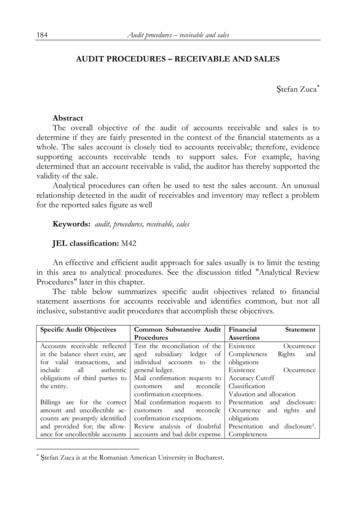
Transcription
184Audit procedures – receivable and salesAUDIT PROCEDURES – RECEIVABLE AND SALESȘtefan Zuca AbstractThe overall objective of the audit of accounts receivable and sales is todetermine if they are fairly presented in the context of the financial statements as awhole. The sales account is closely tied to accounts receivable; therefore, evidencesupporting accounts receivable tends to support sales. For example, havingdetermined that an account receivable is valid, the auditor has thereby supported thevalidity of the sale.Analytical procedures can often be used to test the sales account. An unusualrelationship detected in the audit of receivables and inventory may reflect a problemfor the reported sales figure as wellKeywords: audit, procedures, receivable, salesJEL classification: M42An effective and efficient audit approach for sales usually is to limit the testingin this area to analytical procedures. See the discussion titled "Analytical ReviewProcedures" later in this chapter.The table below summarizes specific audit objectives related to financialstatement assertions for accounts receivable and identifies common, but not allinclusive, substantive audit procedures that accomplish these objectives.Specific Audit ObjectivesAccounts receivable reflectedin the balance sheet exist, arefor valid transactions, andincludeallauthenticobligations of third parties tothe entity.Billings are for the correctamount and uncollectible accounts are promptly identifiedand provided for; the allowance for uncollectible accounts Common Substantive AuditProceduresTest the reconciliation of theaged subsidiary ledger ofindividual accounts to thegeneral ledger.Mail confirmation requests tocustomersandreconcileconfirmation exceptions.Mail confirmation requests tocustomersandreconcileconfirmation exceptions.Review analysis of doubtfulaccounts and bad debt expenseȘtefan Zuca is at the Romanian American University in urrenceCompleteness Rights andobligationsExistenceOccurrenceAccuracy CutoffClassificationValuation and allocationPresentation and disclosure:Occurrence and rights andobligationsPresentation and disclosure1.Completeness
Romanian Economic and Business Review – Special issueis adequate.Receivablesareproperlyclassified in the balance es are adequate withrespect to assigned, pledged,unbilled, discounted, andrelated-party receivables, ressed.and related documents.Review bank confirmations forindications of liens onreceivables.Inquire about receivables thathave been assigned, pledged,unbilled, or discounted or arewith related parties.Review aged subsidiary ledgerof individual accounts foramounts due from employees,credit balances, or unusualitems.185Presentation and ntation and disclosure:Accuracy and valuationReconciling the Aged Subsidiary Ledger of Individual Accounts to theGeneral LedgerThe first step in auditing accounts receivable is to reconcile the aged subsidiaryledger of individual accounts to the general ledger control account. This is ordinarilydone before any other tests to assure the auditor that the population being testedagrees with the general ledger. In addition, the auditor traces a sample of individualbalances to supporting documents, such as duplicate sales invoices, to verify thecustomer name, balance, and proper aging.Confirmation of Accounts ReceivableThe Confirmation Process states that the confirmation of accounts receivable isa generally accepted auditing procedure and should be performed in all auditengagements, except under one or more of the following circumstances:1. The accounts receivable balance is immaterial to the financial statements.2. It is expected that the use of confirmations would be ineffective.3. The auditor's combined assessed level of inherent risk and control risk is low,and the assessed level, in conjunction with the evidence expected to be provided byanalytical procedures or other substantive tests of details, is sufficient to reduce auditrisk to an acceptably low level for the applicable financial statement assertions.Although the confirmation of accounts receivable is not necessary when auditrisk can otherwise be reduced to an "acceptably low level, Statements of AuditingStandards points out that such a situation is unusual by stating that "in manysituations, both confirmation of accounts receivable and other substantive tests ofdetails are necessary to reduce audit risk to an acceptably low level for the applicablefinancial statement assertions."From a practical standpoint, it is rare that a sample of receivables is notcircularized for confirmation where receivables are material, as third-partyverification of an entity's records provides greater audit assurance than evidence fromwithin the entity. When the auditor concludes that it is not necessary to confirmaccounts receivable, that position must be documented in the workpapers, along with
186Audit procedures – receivable and salesthe way the auditor overcame the Statements of Auditing Standards generalrequirement to do so. Thus, the workpapers must include a full explanation based onone or more of the three circumstances listed above.When performing confirmation procedures, the auditor must use judgment todetermine the following: Design of confirmation request Confirmation date Number of accounts to be confirmedDesign of confirmation request The Confirmation Process states that, whendesigning the confirmation request, the auditor should consider the following factors: Form of confirmation request Auditor's prior experience with the client Nature of information being confirmed Characteristics of respondentsForm of confirmation request Two common types of confirmations are used forconfirming accounts receivable: positive and negative.A positive confirmation request is addressed to the customer requesting that itsend directly to the auditor confirmation of whether the balance stated on theconfirmation request is correct or incorrect. A negative confirmation request isaddressed to the customer and requests a response only if the customer disagreeswith the stated amount on the confirmation request. A positive confirmation requestis considered more reliable because it requires affirmative action on the part of thedebtor.The determination of which type of confirmation to use is an auditor's decisionand is based on (1) the strength of the client's internal controls, (2) the nature of theaccounts receivable population, and (3) the facts and circumstances of the individualaudit. A more detailed explanation of positive and negative confirmations follows:1 Positive confirmation request—A positive confirmation may be designed in two ways. Theinformation to be confirmed may be indicated in the confirmation request, or the request may beblank, requiring the respondent to fill in the missing information. There is a trade-off in the selectionof the complete or incomplete request. When an incomplete form is completed and returned by arespondent, more competent evidence is created than when the respondent is simply asked to sign acompleted confirmation form. However, when the incomplete form is used, the response rate generallywill be lower and it may be necessary to perform alternative audit procedures to supplement theconfirmation process. When a positive confirmation is used and the request is not returned, no auditevidence is created.2 Negative confirmation request—A negative confirmation form requires the respondent toreturn the confirmation only if there is disagreement with the amount owed. When negative confirmations are not returned, the evidence generated is different from that generated when positiveconfirmations are used. That is, the lack of returned negative confirmations provides only implicitevidence that the information is correct. The Confirmation Process describes this limitation asfollows:
Romanian Economic and Business Review – Special issue187Unreturned negative confirmations do not provide explicit evidence that theintended third parties received the confirmation requests and verified that theinformation contained on them is correct.Because of this limitation, the negative confirmation form should be used onlyunder the following conditions: The combined assessed level of inherent and control risk is low. The audit population contains a large number of relatively small individualbalances. There is no reason to believe that respondents will not give adequateattention to confirmation requests.Even under the conditions described above, Statements of Auditing Standardsexpresses a concern that the use of negative confirmations will not generatesufficient competent evidential matter and concludes that "the auditor shouldconsider performing other substantive procedures to supplement the use of negativeconfirmations." For example, if the auditor uses negative confirmations to test theexistence of accounts receivable, it may also be advisable to use additional tests, suchas reviewing subsequent cash collections and vouching, to determine with reasonableassurance that accounts receivable do exist.When a response is received from a negative confirmation indicatingdisagreement with the amount owed, the auditor should investigate the reason forthe disagreement. If there are a number of disagreements or the disagreementsappear to be significant, the auditor should reconsider the original assessment of thelevel of inherent and control risk. This reassessment may lead to the conclusion thatthe combined assessed level of inherent and control risk is not low, in which case theauditor should modify the originally planned audit approach appropriately.Auditor's prior experience with the client When designing confirmation requests, theauditor should consider information from prior experience with the client and withsimilar clients. This information includes response rates, knowledge of misstatementsidentified during prior years' audits, and any knowledge of inaccurate information onreturned confirmations. Prior experience may suggest, for example, that aconfirmation form was improperly designed or previous response rates were so lowthat audit procedures other than confirmation should be considered.Nature of information being confirmed The auditor should consider the capabilities ofthe respondents when determining what to include in the confirmation request.Respondents can confirm onlywhat they are capable of confirming, and there is a tendency to confirm onlywhat is relatively easy to confirm. For example, when designing an accountsreceivable confirmation, the auditor should consider whether respondents are morecapable of verifying an individual account balance or transactions that make up asingle account receivable balance.Information to be confirmed with respondents should not be limited to dollaramounts. For example, in complex transactions it may be appropriate to confirm
188Audit procedures – receivable and salesterms of contracts or other documentation that supports such transactions. Inaddition, it may be appropriate to confirm information that is based on oralmodifications and, therefore, not part of the formal documentation. Statements ofAuditing Standards provides the following guidance with respect to oralmodifications:When the auditor believes there is a moderate or high degree of risk that theremay be significant oral modifications, he or she should inquire about the existenceand details of any such modifications to written agreements.If the client responds to the auditor's inquiry by stating that there are no oralmodifications to an agreement, the auditor should consider confirming with theother party to the agreement that no oral modifications exist.Characteristics of respondents Confirmation requests should be addressed torespondents who will generate meaningful and competent evidential matter. Factorsto be considered in this regard include the following: Competence of the recipient—Recipients may be apathetic about the confirmation process,and management may have assigned responsibility to an individual who will sign and returnthe confirmation without adequate concern for its accuracy. Knowledge of the respondent—Confirmations may be signed by persons who have noknowledge of the account and no authority to respond. Objectivity of the respondent—For example, the reliability of confirmations from relatedparties may be questionable.If information concerning the above factors, as well as other relevant factors,comes to the auditor's attention, and that information suggests that meaningful andcompetent evidential matter will not result from the confirmation process, theauditor should consider using other audit procedures to test financial statementassertions.Statements of Auditing Standards specifically warns that under some circumstances the level of professional skepticism should be increased, resulting in a closerscrutiny of the respondent. Two examples presented in The Confirmation Processare: (1) significant, unusual year- end transactions that are material or (2) where therespondent is the custodian of a material amount of the client's assets.Confirmation dateThe confirmation date relates to the timing of the confirmation procedures.Whether confirmations are requested as of year end or as of some other date willdepend on the overall design of the audit approach, with the aim of making theexamination more efficient or meeting client deadlines. A confirmation date otherthan year end can be justified when internal controls are sufficiently reliable toproduce reasonably accurate revenue and collection data between the confirmationdate and year end. Otherwise, confirmation must be performed at or very near to thebalance-sheet date. Other factors the auditor should consider when deciding on a
Romanian Economic and Business
Confirmation of Accounts Receivable The Confirmation Process states that the confirmation of accounts receivable is a generally accepted auditing procedure and should be performed in all audit engagements, except under one or more of the following circumstances: 1. The accounts receivable balance is immaterial to the financial statements. 2. It is expected that the use of confirmations would be ineffective.File Size: 245KBPage Count: 11
